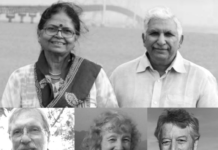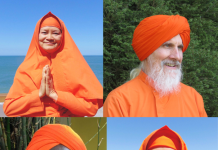An anandamargii is the one who chose to follow the philosophy of Shrii Shrii Anandamurti, accepting the mission of self-realization (atma moksartham) and service to the creation (jagat hitaya ca). Thus, the essence of being a margii is to always be engaged in relevant work, constantly working to accomplish the task. How have margiis accomplished this work? How do they get inspired? What difficulties do they encounter? These and other questions will be examined here, in the second part of the special series “dharma pracar workers”, based on the experiences of four Brazilian margiis.
There are lots of opportunities for margiis to do pracar. They can support the development of the organizations that make up the Ananda Marga community, working in one or more of their various departments – for example, AMURT / AMURTEL (focused on relief work) or RAWA (focused on art for raising awareness). They can also incorporate different aspects of the philosophy and practice into their own work, whether they are leaders, managers, entrepreneurs, teachers, yoga instructors, etc.
Soma Devii (Sandra Brys), a 28-year-old resident of the master unit Ananda Kiirtana (Belmiro Braga, MG) and a margii since 1980, says she is “fortunate by Baba’s grace to have found this path.” Fueled by this grace, she dedicates herself exclusively to education, as founder and nowadays director of the Sol Nascente Rural School (part of the master unit). Both the school and the trainings, workshops, and lectures she gives, as well as the children’s stories and songs she writes, are based on neo-humanism. According to Soma, one of the roles of a margii is to use the rich teachings of Baba and his immediate disciples to “create appropriate didactics that present this knowledge in an accessible way.”
Rajendra (Ricardo Almeida) from Rio de Janeiro (RJ), a margii since since 1981, has worked for many years in the organizational side of Ananda Marga in Brazil, and nowadays he organizes introductory courses in playing kiirtan and in the philosophy in the jagrti in Rio de Janeiro. For him, a pracaraka is one who “seeks to spread dharma in its best form, inspired by the teachings and by one’s proximity to Taraka Brahma, in order to help everyone evolve physically, mentally and psychically.”
Kalyanika (Carla Cavalheiro), from Caxias do Sul (RS), met Ananda Marga in 2004 through the courses of the Visão Futuro Institute, based on Baba’s philosophy. She ended up working for a few years in the institute’s programs and bringing meditation and yoga techniques to a larger audience. Today, she organizes a meditation and yoga group in her space and she created the movement MeditAMOR, which brings kiirtan and devotional music to retreats and congresses with a spiritual theme. For Kalyanika, another great engine for pracar is devotion: “What keeps me on my feet is the overwhelming love, which is totally beyond my control, that I feel for Baba, and which I feel that He also feels for me.”
Lalan (Lucas Becker), from Pelotas (RS), was initiated in 2013. He founded the “Yogue-se Pelotas” project, with yoga and meditation classes, but without the dharmacakra format, as a gateway to the philosophy. In addition, he promotes courses in vegetarian food, spiritual philosophy, mantras, health and medicine, and various other aspects of Anandamurti’s work. “These practices support and shelter the core structure and give the pracaraka more credibility in the eyes of the local population.”
For Lalan, margiis must bring pracar everywhere and in every possible way, although “it is not necessary to always raise the flag of Ananda Marga”. He argues that “a yogii is one who incessantly strives to unite his individual consciousness with the Cosmic Consciousness. But to be a margii is to go beyond that: it is to strive to assume the role of sadvipra in society. ”
However, the road to pracar has some stones. Kalyanika mentions religious dogma in the region in which she works. Rajendra, for his part, believes that a major challenge is to adjust the traditional activities of the jagritis to the modern-day Western mentality. According to him, the solution would be a gradual approach, in which one would start to attend dharmacakra only after having spent a minimum period of time learning the philosophy – as Lalan has done in his projects.
Soma highlights structural challenges, such as the low number of books translated and the need for a greater systematization and organization of the themes in Ananda Marga work, in a standardized way. Kalyanika mentions the difficulties of maintaining a group of practicing and engaged volunteers.
Whatever the difficulties, they are aggravated by the political dispute that, according to Lalan, exists today in the organization. “Many acaryas are wasting time and energy on individual problems, geo-groups and socio-groups. When the goal of creating a more humane society takes a back seat, the damage is immeasurable. ”
Despite the challenges, everyone agrees that the current climate of ethical, political, social, and economic crisis is propitious for presenting the philosophy to the people. It is also agreed that for this to happen it is necessary to adapt the language to the audience. “Since Sarkar’s work is immense and goes far beyond human capacity, different approaches are important to be able to attract people with diverse interests,” concludes Lalan.
How many other committed and inspiring margiis exist in Brazil and in the world? What is their successful pracar work? What difficulties do they encounter? How are they meeting these challenges? If you have a project and would like to make it public, or would like to bring attention to someone else’s project, write to us at journal@d4all.org. Soon, we will launch a tool for spreading dharma projects around the world.
Read here the part 1 of this series.






